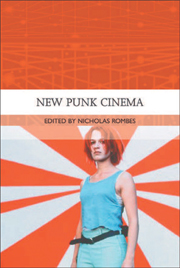1 - Punk Cinema
from PART I - BACKGROUNDS AND CONTEXTS
Published online by Cambridge University Press: 05 August 2013
Summary
There is nothing sexy about materialist critique which is why it is often ignored in favour of ideological analysis or aesthetic evaluation. That said, it is precisely to materialist critique that I want to turn, as I propose a definition for ‘punk cinema’ in this essay. Two pieces of punk culture should prove instructive toward this end. The first is the famous set of diagrams, from a 1976 issue of the punk-zine, Sideburns, that demonstrates the proper tablature for three guitar chords – A, E, and G. Four short sentences accompany them: ‘This is a chord. This is another. This is a third. Now form a band.’ This set of directions and blunt demand contain within themselves, in compressed form, the logic of punk and, by association and extension, that of punk cinema. Punk clearly has little to do with technical proficiency: the punk guitarist need only know three chords. Furthermore, as the diagrams suggest, punk is profoundly democratic: anyone should be able to play it. It is a socialised mode of music-making and performance in the sense that Walter Benjamin describes when he comments (on authorship) that ‘what matters … is the exemplary character of production, which is able first to induce other producers to produce’ (Benjamin 1978: 233). By by foregrounding its simplicity, punk produces producers. It propels potential producers over the gap between production and consumption, and it is this shift that socialises the music, which is not produced by an elite technocracy but by anyone who cares to create it.
- Type
- Chapter
- Information
- New Punk Cinema , pp. 21 - 38Publisher: Edinburgh University PressPrint publication year: 2005



